1994 CHEVROLET BLAZER jump start
[x] Cancel search: jump startPage 164 of 348
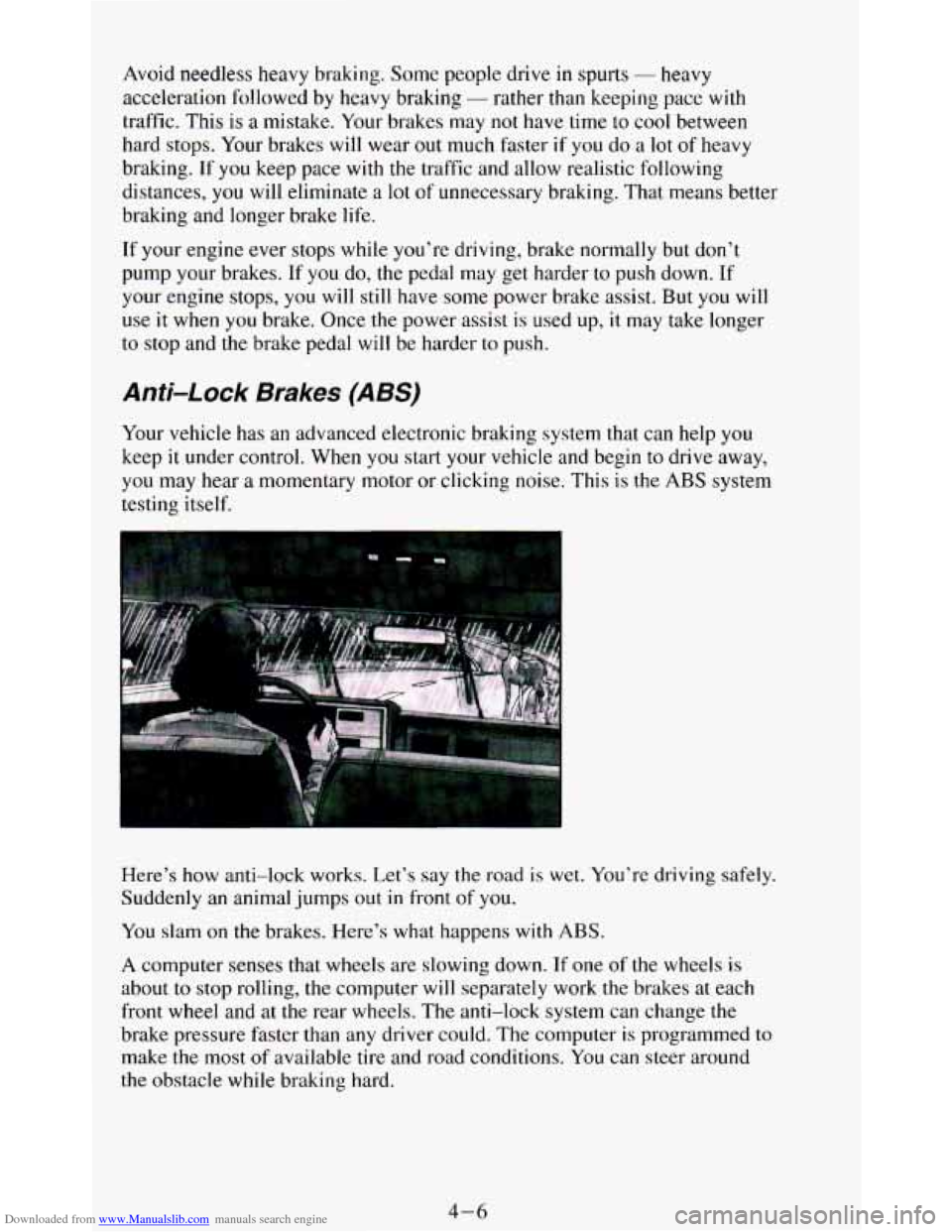
Downloaded from www.Manualslib.com manuals search engine Avoid needless heavy braking. Some people drive in spurts - heavy
acceleration followed by heavy braking
- rather than keeping pace with
traffic. This is a mistake. Your brakes may not have time to cool between
hard
stops. Your brakes will wear out much faster if you do a lot of heavy
braking. If
you keep pace with the traffic and allow realistic following
distances, you will eliminate a
lot of unnecessary braking. That means better
braking and longer brake life.
If your engine ever stops while you’re driving, brake normally but don’t
pump your brakes. If
you do, the pedal may get harder to push down. If
your engine stops, you will still have some power brake assist. But you will
use it when you brake. Once the power assist is used up, it may take longer
to stop and the brake pedal will be harder to push.
Anti-Lock Brakes (ABS)
Your vehicle has an advanced electronic braking system that can help you
keep it under control. When you start your vehicle and begin to drive away,
you may hear
a momentary motor or clicking noise. This is the ABS system
testing
itself.
Here’s how anti-lock works. Let’s say the road is wet. You’re driving safely.
Suddenly
an animal jumps out in front of you.
You slam
on the brakes. Here’s what happens with ABS.
A computer senses that wheels are slowing down. If one of the wheels is
about to stop rolling, the computer will separately work the brakes at each
front wheel and at the rear wheels. The anti-lock system can change the
brake pressure faster than any driver could. The computer
is programmed to
make the most of available tire and road conditions. You can steer around
the obstacle while braking hard.
4-6
Page 203 of 348
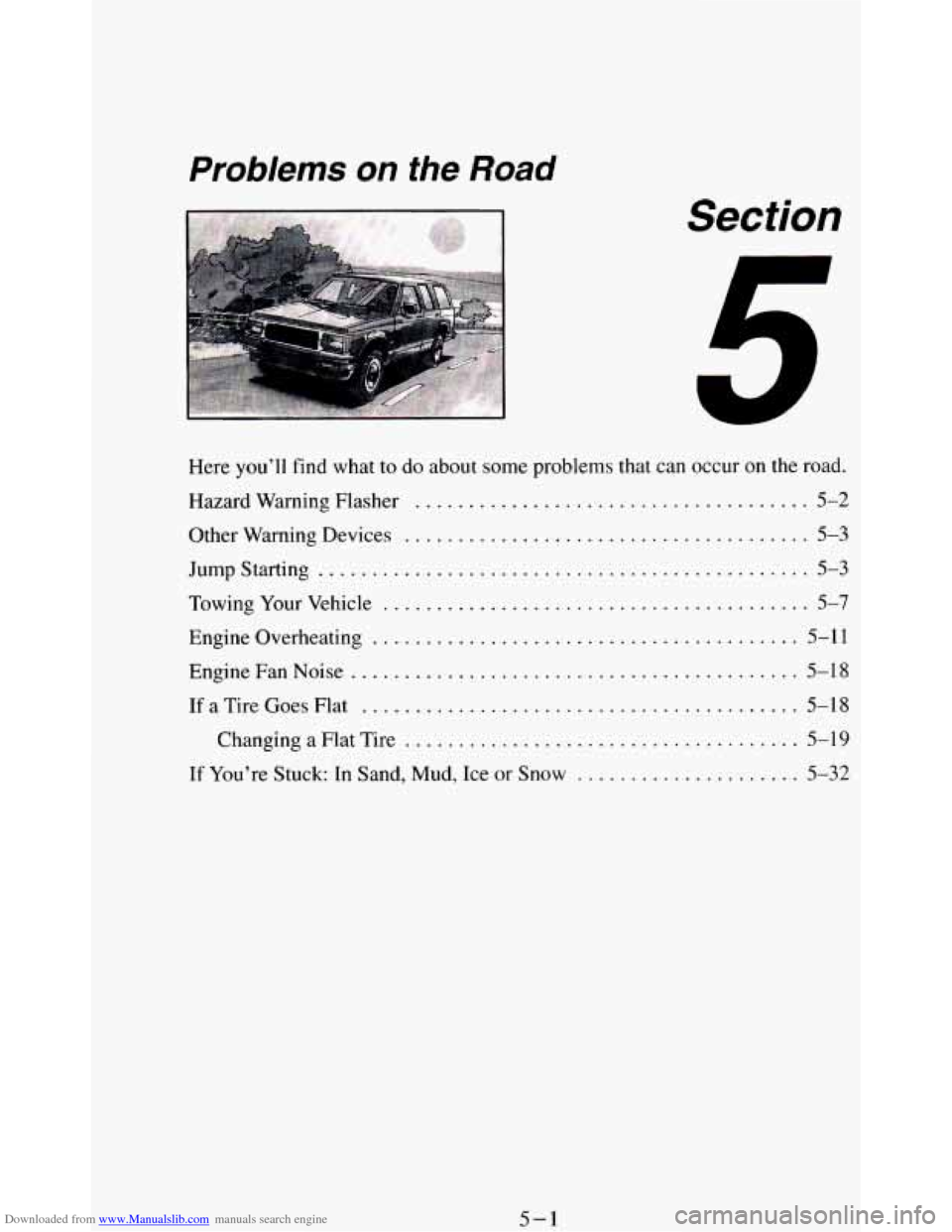
Downloaded from www.Manualslib.com manuals search engine Here you’ll find what to do about some problems
Hazard Warning Flasher
...................
Other Warning Devices ....................
Jump Starting ............................
Towing Your Vehicle ......................
Engine Overheating .......................
Engine Fan Noise .........................
If a Tire Goes Flat ........................
Changing a Flat Tire ....................
If You’re Stuck: In Sand. Mud. Ice or Snow ....
Seciion
that can occur on
..............
..............
..............
..............
..............
..............
the road .
....
5-2
.... 5-3
.... 5-3
.... 5-7
... 5-11
... 5-18
................. 5-18
................. 5-19
................. 5-32
5-1
Page 205 of 348
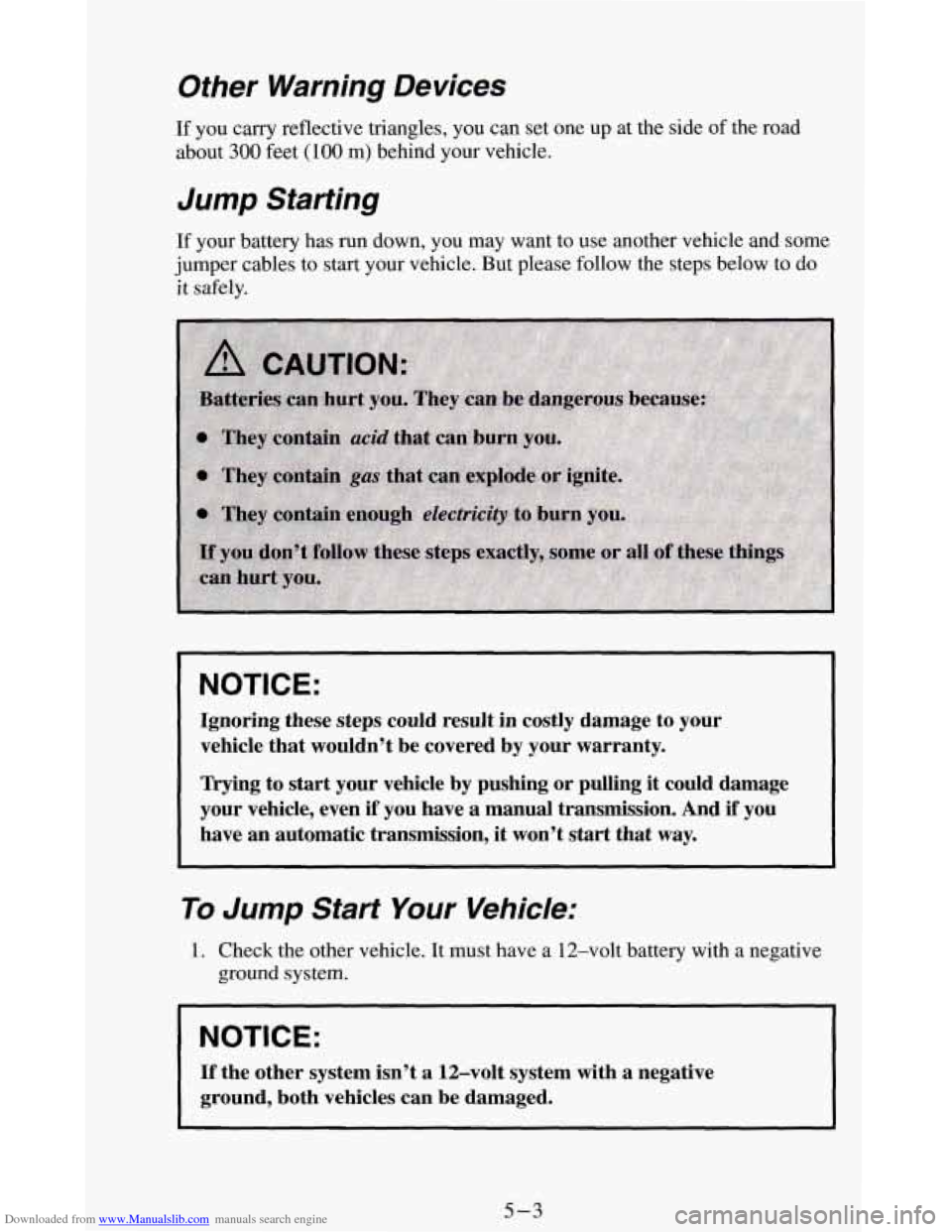
Downloaded from www.Manualslib.com manuals search engine Other Warning Devices
If you carry reflective triangles, you can set one up at the side of the road
about
300 feet (100 m) behind your vehicle.
Jump Starting
If your battery has run down, you may want to use another vehicle and some
jumper cables to start your vehicle. But please follow the steps below to
do
it safely.
NOTICE:
Ignoring these steps could result in costly damage to your
vehicle that wouldn’t be covered by your warranty.
Trying to start your vehicle by pushing or pulling it could damage
your vehicle, even
if you have a manual transmission. And if you
~ have an automatic transmission, it won’t start that way.
To Jump Start Your Vehicle:
1. Check the other vehicle. It must have a 12-volt battery with a negative
ground system.
NOTICE:
If the other system isn’t a 12-volt system with a negative
ground, both vehicles can be damaged.
5-3
Page 206 of 348
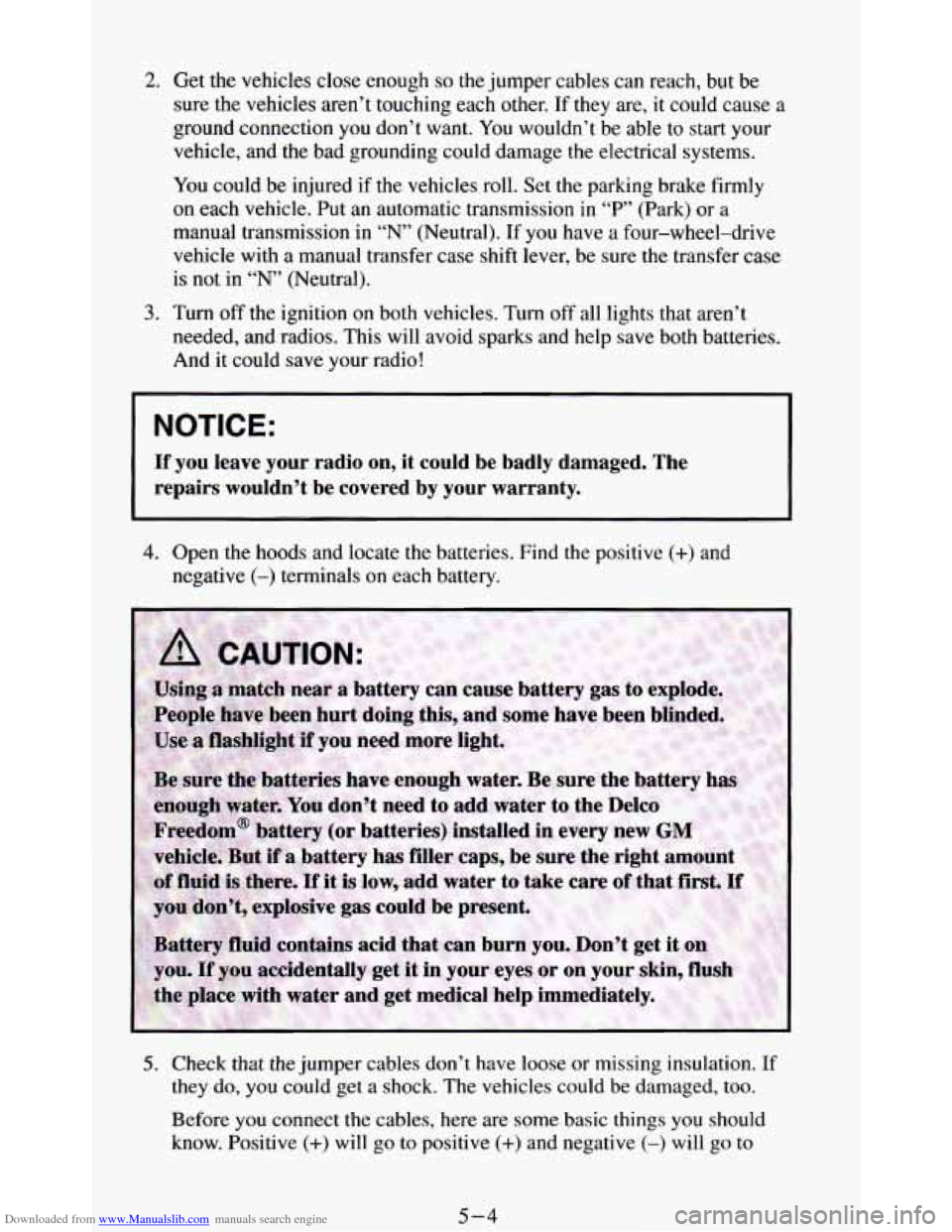
Downloaded from www.Manualslib.com manuals search engine 2.
3.
Get the vehicles close enough so the jumper cables can reach, but be
sure the vehicles
aren’t touching each other. If they are, it could cause
ground connection you don’t want. You wouldn’t be able to start you1
vehicle, and the bad grounding could damage the electrical systems.
You could be injured if the vehicles roll. Set
the parking brake firmly
on each vehicle. Put an automatic transmission in “P’ (Park) or a
a
manual transmission in “N” (Neutral). If you have a four-wheel-drive
vehicle with
a manual transfer case shift lever, be sure the transfer case
is not in “N” (Neutral).
Turn
off the ignition on both vehicles. Turn off all lights that aren’t
needed, and radios. This will avoid sparks and help save both batteries.
And it could save your radio!
~~~
NOTICE:
~~
If you leave your radio on, it could be badly damaged. The
repairs wouldn’t be covered by your warranty.
4. Open the hoods and locate the batteries. Find the positive (+) and
negative (-) terminals on each battery.
5. Check that the jumper cables don’t have loose or missing insulation. If
they do, you could get a shock. The vehicles could be damaged, too.
Before you connect the cables, here are some basic things you should
know. Positive
(+) will go to positive (+) and negative (-) will go to
5-4
Page 341 of 348
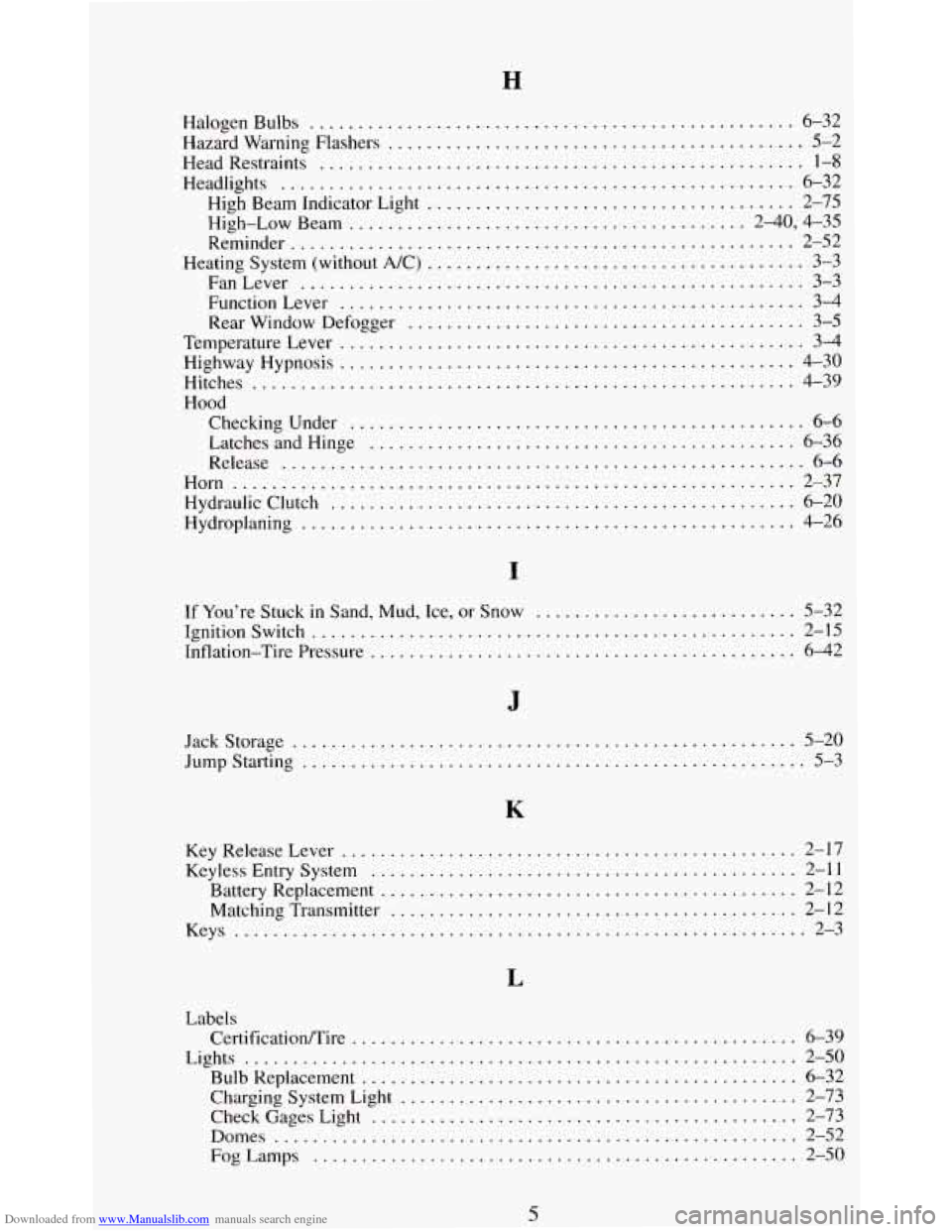
Downloaded from www.Manualslib.com manuals search engine H
HalogenBulbs .................................................. 6-32
Headlights
..................................................... 6-32
Hazard Warning Flashers
........................................... 5-2
Head Restraints
.................................................. 1-8
High Beam indicator Light ...................................... 2-75
High-LowBeam
......................................... 2-40. 4-35
Reminder
.................................................... 2-52
Heating System (without
A/C) ....................................... 3-3
FanLever
.................................................... 3-3
FunctionLever
................................................ 3-4
Rear Window Defogger
......................................... 3-5
Temperature Lever ................................................ 3-4
Highway Hypnosis
............................................... 4-30
Hitches
.................................................... 4-39
Hood Checking Under
............................................... 6-6
LatchesandHinge
............................................ 6-36
Release
...................................................... 6-6
Horn
.......................................................... 2-37
Hydraulic Clutch
................................................ 6-20
Hydroplaning
................................................... 4-26
If You're Stuck in Sand. Mud. Ice. or Snow ........................... 5-32
Ignition Switch
.................................................. 2-15
Inflation-Tire Pressure
............................................ 6-42
Jackstorage
.................................................... 5-20
Jumpstarting
.................................................... 5-3
K
KeyReleaseLever ............................................... 2-17
Keyless Entry System
............................................ 2-11
Battery Replacement
........................................... 2-12
Matching Transmitter
.......................................... 2-12
Keys
........................................................... 2-3
Labels Certification/Tire
.............................................. 6-39
Bulb Keplacetnent
............................................. 6-32
Charging System Light
......................................... 2-73
Check Gages Light
............................................ 2-73
Domes
...................................................... 2-52
FogLamps
.................................................. 2-50
Lights
......................................................... 2-50
5